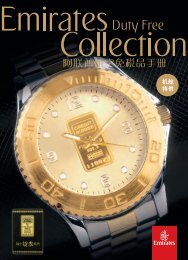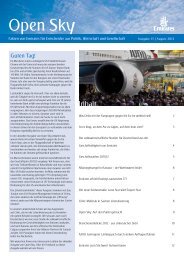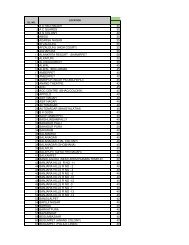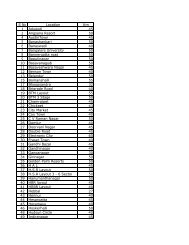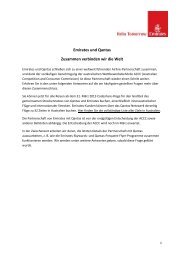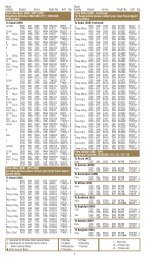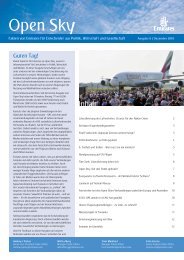Annual Report 2008-2009 - Emirates.com
Annual Report 2008-2009 - Emirates.com
Annual Report 2008-2009 - Emirates.com
You also want an ePaper? Increase the reach of your titles
YUMPU automatically turns print PDFs into web optimized ePapers that Google loves.
<strong>Emirates</strong><br />
078<br />
2. Summary of significant accounting policies (continued)<br />
Goodwill and fair value adjustments arising on the acquisition of a foreign entity are treated as assets and liabilities of the foreign entity<br />
and translated at the exchange rates ruling on the balance sheet date.<br />
Taxation<br />
Taxation is provided for as and when the liability arises except where management is of the firm opinion that exemption from such<br />
taxation will ultimately be granted by the relevant authorities in the countries concerned.<br />
Deferred in<strong>com</strong>e tax<br />
Deferred in<strong>com</strong>e tax is provided in full, using the liability method, on temporary differences arising between the tax bases of assets and<br />
liabilities and their carrying amounts in the consolidated financial statements. However, deferred in<strong>com</strong>e tax is not accounted for if it<br />
arises from initial recognition of an asset or liability in a transaction other than a business <strong>com</strong>bination that at the time of the transaction<br />
affects neither accounting nor taxable profit or loss. Deferred in<strong>com</strong>e tax is determined using tax rates (and laws) that have been enacted<br />
or substantially enacted by the balance sheet date and are expected to apply when the related deferred in<strong>com</strong>e tax asset is realised or<br />
the deferred in<strong>com</strong>e tax liability is settled.<br />
Property, plant and equipment<br />
Property, plant and equipment is stated at cost less accumulated depreciation. Cost consists of purchase cost, together with any<br />
incidental expenses of acquisition.<br />
Subsequent costs are included in the asset’s carrying amount or recognised as a separate asset, as appropriate, only when it is probable<br />
that future economic benefits associated with the item will flow and the cost can be reliably measured. Repairs and maintenance are<br />
charged to the consolidated in<strong>com</strong>e statement during the period in which they are incurred.<br />
Land is not depreciated. Depreciation is calculated on other items of property, plant and equipment so as to write off its cost, less<br />
estimated residual values, on a straight-line basis over the estimated useful lives of the assets concerned. The estimated useful lives and<br />
residual values are:<br />
Passenger aircraft - new 15 years (residual value 10%)<br />
Passenger aircraft - used 8 years (residual value 10%)<br />
Aircraft engines and parts 5 - 15 years (residual value 0 - 10%)<br />
Buildings 5 - 20 years<br />
Other property, plant and equipment 3 - 15 years or over the lease term, if shorter<br />
Major overhaul expenditure is depreciated over the shorter of the period to the next major overhaul or lease term or useful life of the asset<br />
concerned.<br />
The assets’ residual values and useful lives are reviewed, and adjusted if appropriate, at each balance sheet date.<br />
When the carrying amount of an asset is greater than its estimated recoverable amount, it is written down immediately to its estimated<br />
recoverable amount and is reviewed at each balance sheet date for possible reversal of the impairment loss.<br />
Capital projects are stated at cost. When the asset is ready for its intended use, it is transferred from capital projects to the appropriate<br />
category under property, plant and equipment and depreciated in accordance with <strong>Emirates</strong>’ policies.<br />
Gains and losses on disposal are determined by <strong>com</strong>paring proceeds with the carrying amount and recognised in the consolidated<br />
in<strong>com</strong>e statement.<br />
Borrowing costs<br />
Borrowing costs directly attributable to the acquisition, construction or production of qualifying assets are added to the cost of the assets<br />
until such time the assets are substantially ready for their intended use. Where funds are borrowed specifically for the purpose of<br />
obtaining a qualifying asset, any investment in<strong>com</strong>e earned on temporary surplus funds is deducted from borrowing costs eligible for<br />
capitalisation.<br />
All other borrowing costs are recognised as an expense when incurred.





